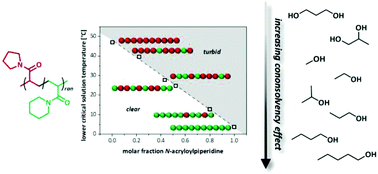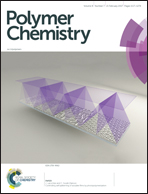Cononsolvency in the ‘drunken’ state: the thermoresponsiveness of a new acrylamide copolymer in water–alcohol mixtures†
Abstract
Stimuli-responsive ‘smart’ polymers are a promising class of materials for switchable devices. In this work, we present poly[N-acryloylpiperidine-random-N-acryloylpyrrolidine] (poly[APi-r-APy]) as a novel thermoresponsive copolymer which was synthesised by reversible addition–fragmentation chain transfer (RAFT) polymerisation in a controlled manner. One of its attractive features is that the lower critical solution temperature (LCST) in aqueous solution, i.e. the temperature at which the polymer instantaneously becomes insoluble, can be freely adjusted between 3 °C and 47 °C. This adjustment is indeed extremely straightforward because the LCST of the copolymer is linearly dependent on the copolymer composition. We furthermore discuss the influence of the addition of a second ‘good’ solvent to polymer–water solutions on the thermoresponsiveness of the system. Depending on the nature of the additive, the cloud point can be shifted both upwards and downwards. Our research is focused on alcoholic additives, with systematic variation of the chemical structure of the alcohol, which resulted in the occurrence of remarkable cononsolvency effects. The results are discussed in terms of polymer–additive as well as additive–water interactions and help to gain a more detailed understanding of water interactions with amphiphilic additives and, hence, of cononsolvency phenomena. This work moreover contributes to the systematic design of switchable systems with tailored phase transition properties.



 Please wait while we load your content...
Please wait while we load your content...